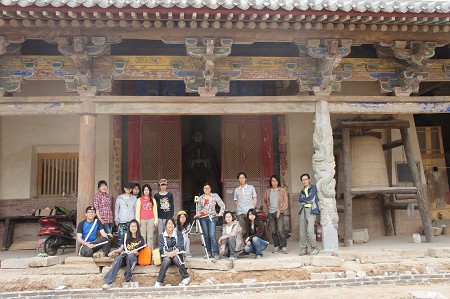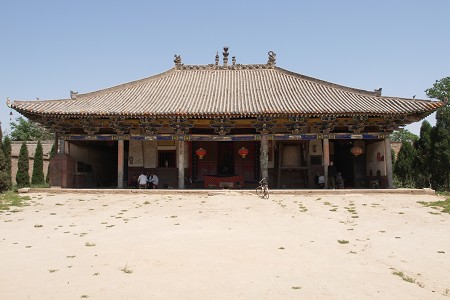News & Events | About PKU News | Contact | Site Search
Peking University, May 24, 2011: PKU professors and students found the only remaining 11th-century Wudian-roof Building in north China's Shanxi Province on May 14, 2011.
During the ongoing mapping of Shanxi Wanrong Jiwang Temple hall after the renovation, professors and students of Peking University (PKU) found some unobvious brush marks on a tie beam beneath a purlin under the eaves. Due to long-term exposure to the air, there were only four characters of them identifiable. After the wet processing on the surface, it can be confirmed that the inscription was “Tiansheng Yuan Nian” (the first year of Tiansheng period, CE 1023).
The discovery of this chronology not only provided accurate era of the building, which helped to identify it as the remaining Wudian-roof (with four slopes and five ridges) Building of Song Dynasty (960-1279), but also laid a solid foundation for highlighting its important historical value, scientific value and research value.

Teachers and students participating in the survey
In 2007, the PKU School of Archaeology and Museology conducted a field survey in Wanrong, Shanxi Province. According to its architectural form, the temple was initially determined to be built in Song Dynasty. Then during the following years, PKU conducted a systematic research on buildings of Song and Yuan Dynasty in Linfen, Yuncheng from the chronology of architectural form to the building materials analysis, which strengthened the understanding for Jiwang Temple and the wooden-structure building in Song Dynasty.
In 2010, the PKU School of Archaeology and Museology, together with Shanxi Institute of Ancient Architecture Conservation and other units, declared the Wanrong Jiwang Temple as an ancient Chinese architecture fine mapping project in the Compass Plan of China’s State Administration of Cultural Heritage. Considering the renovation situation, the mapping research for the Jiwang Temple would be carried out for three times in order to make sure to keep the cultural relics and historical information as much as possible.
Jiwang Temple is regarded as a protected national key culture relic site. Now there is a hall, which is five-bay wide and three bays in breadth, with a single-eave Wudian roof, and a stage now.

The facade of the hall in Jiwang Temple
Renowned Chinese architect Liang Sicheng (1901-72) once regretted that he hadn’t seen any remaining Wudian-roof buildings of Song Dynasty in China. The finding by PKU professors and the students majoring in heritages and historic architecture, presented this building coincided with the 110th birth anniversary of Liang.
Since the discipline of heritage and relics building was established at PKU, it has been based on the theory of historical archaeology and devoted to probing the archaeology research method for ancient wooden-structure architecture. The discovery mentioned above is a great teaching achievement after the School of Archaeology and Museology’s year-round work, yet also proves that it’s still a long way to go before finishing all the researches on Chinese ancient architecture. More scientific methods should be used to sort out the development of ancient Chinese architectural context — in order to restore the historical process — and thus reveal its historical significance to the history of culture heritage protection and repair. Value research is also essential to the management and use, which will be helpful to enhance the overall value of China's culture heritage in an effective way.
Reported by: Xu Yitao
Translated by: Duan Ranjia
Edited by: Arthars
Source: PKU News (Chinese)